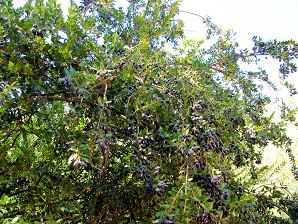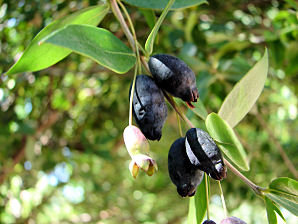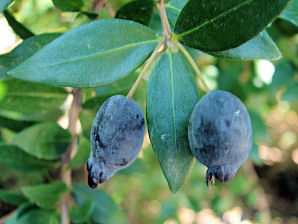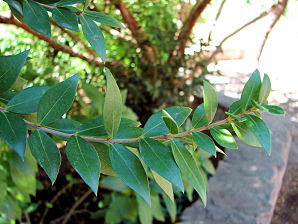Xeriscape Landscaping Plants For The Arizona Desert Environment.
Pictures, Photos, Information
Descriptions, Images, & Reviews.
Shrubs.
Common Myrtle, Myrtus communis.
We Are Proud Of Our SafeSurf Rating!
Click On Any Of The Following Links By Amazon.Com
For Books, & Videos About Wildflowers Of Arizona & The Southwest USA. No Obligation!
 |
| Common Myrtle, Myrtus communis. October 11, 2006. Boyce Thompson Arboretum, Near Superior, Arizona. |
|---|
 |  |
| Common Myrtle Fruit. Myrtus communis. | Common Myrtle Berries. Myrtus communis. |
|---|---|
 |  |
| Common Myrtle. Myrtus communis. | Common Myrtle. Myrtus communis. |
Common Myrtle.
We wish to thank Wikipedia, the free encyclopedia for some of the information on this page. We share images and information with Wikipedia. Myrtus communisis an evergreen shrub or small tree with dense foliage. The 2-inch lanceolate leaves are strongly scented when crushed. Myrtles have been cultivated for centuries and they are thought to be native of the Mediterranean Area. They are in leaf all year, in flower from July to August, and the seeds ripen in October. The flowers are hermaphrodite (they have both male and female organs) and are pollinated by Bees. The plant is self-fertile. The plant requires well-drained soil. DO NOT OVERWATER! The fruit has an aromatic flavor and can be eaten fresh when ripe or can be dried and it then can be used as an aromatic food flavouring, especially in the Middle East. It can also be made into a drink.
Quick Notes:
Height: Up to about 5 - 8 feet tall and 5 - 8 feet wide. Can grow up to 15 feet tall and 15 feet wide as a tree.
Flowers: The flowers are 3/4 inch, white, solitary arising from a leaf axils and consists of four white petals and numerous conspicuous anthers.
Flowering Time: July to August.
Fruit: Ripens in October. Oval 1/2 inch dark blue drupe, edible. Containing several white kidney-shaped seeds.
Leaves: Dark green, opposite, lancelate or oval, up to 2 inches long, aromatic.
Found: Native of the Mediterranean Area.
Hardiness:
Soil pH requirements:
Sun Exposure:
Elevation: 800 - 4,800 feet.
Habitat: Does best in dry, sandy, well-drained/light soils. An ideal xeriscape landscape plant in Arizona.
Miscellaneous: Shrub Photos Taken October 11, 2006. Boyce Thompson Arboretum, Near Superior, Arizona.
|
We Are Proud Of Our SafeSurf Rating!
Click On Any Of The Following Links By Amazon.Com
For Books, & Videos About Wildflowers Of Arizona & The Southwest USA. No Obligation!
| © 1966 - Present, Audrey, Eve, & George DeLange |
